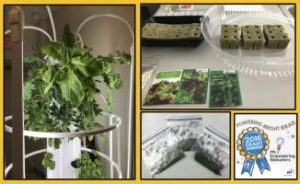Farm-to-table is a phrase that is often discussed in the Family and Consumer Sciences classroom especially in Foods & Nutrition or culinary coursework. The term can mean different things but at its core, farm-to-table means that the food prepared and served was sourced directly from a specific farm, without going through a store, market, or distributor along the way. In an effort to provide students in her Foods & Nutrition classes with real-world, hands-on experiences while learning about and developing healthy eating habits, Sasha Roble from Pennsylvania introduced aeroponics into her curriculum with countertop gardens and a Tower Garden System. Continue reading From Tower to Table: What’s GROWING ON in FCS? to learn more!
can mean different things but at its core, farm-to-table means that the food prepared and served was sourced directly from a specific farm, without going through a store, market, or distributor along the way. In an effort to provide students in her Foods & Nutrition classes with real-world, hands-on experiences while learning about and developing healthy eating habits, Sasha Roble from Pennsylvania introduced aeroponics into her curriculum with countertop gardens and a Tower Garden System. Continue reading From Tower to Table: What’s GROWING ON in FCS? to learn more!
Background Info
“An advanced form of hydroponics, aeroponics is the process of growing plants in an air or mist environment rather than soil. Aeroponic systems use water, liquid nutrients and a soilless growing medium to quickly and efficiently grow more colorful, tastier, better smelling and incredibly nutritious produce.”
While not exactly farm-to-table, incorporating gardening technology like the AeroGraden and the Tower Garden into one’s curriculum provides students with a real-time look at how food is grown and gives them the opportunity to experience: see, smell and taste freshly grown herbs, fruits and vegetables similar to the farm-to-table movement.
Sasha wanted to expand her students’ thinking and learning beyond how to grow one’s food from seed. Lessons learned with these gardening systems included aeroponics, sustainability, urban agriculture, vertical farming, controlled environment agriculture, nutrient content of foods and dietary guidelines and foods preparation techniques.
How an Aeroponic System Works
- Instead of soil, plants grow in a soilless medium called rockwool, which provides plant roots with oxygen and consistent moisture, encouraging rapid, healthy growth.
- A reservoir stores the plant food solution which is a mineral blend mix and water. A timer ensures that the plants receive the ideal amount of oxygen, water and nutrients.
- Aside from a few minor maintenance tasks throughout the week, such as checking water and pH levels and cleaning the pump filter, and pruning, an aquaponics system will take care of itself and in no time, your students will be enjoying delicious homegrown produce!
Supplies
- Miracle Gro AeroGarden Counter Hydroponic System (affiliate link)
- Tower Garden Systems
Funding
- PPL Empowering Educators Grant: PPL’s Empowering Educators grants are designed to help your students create, tinker, explore and create hands-on projects while learning about the world of STEM.
- Donors Choose
Resources
Fan Favorite Recipes
- Oven-Drying: To dry herbs in the oven, set the temperature to 180℉. Line a baking sheet with parchment paper. Arrange the herbs into a single layer, making sure not to overcrowd the sheet. Let them bake in the oven for two to four hours. Note: Keep in mind, the herbs lose some of their flavor because they cook a little bit. So, add a little extra than you normally would when using dried herbs in a recipe.
- Caprese Crostini: Using fresh basil and cherry tomatoes from the gardening systems, and stretching their own fresh mozzarella from locally operated Caputo Brothers Creamery Mozzarella Curd (Spring Grove, PA) students made this quick, delicious appetizer!
- Home-made Salad Dressings
Additional Resources
- Exploring Vertical Aeroponic Farming (TPT Freebie)
- Tower Garden Curriculum — Compare Three Growing Machines (TPT Freebie)
- Seed Starting Procedure for Classrooms Using Rockwool (TPT Freebie)

